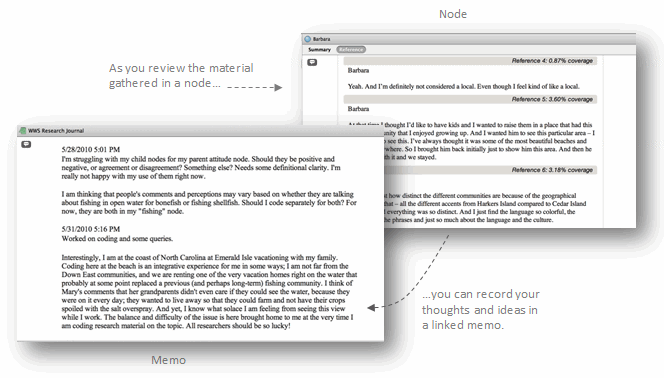Handle your ideas (memos, annotations and links)
This topic describes ways to manage the ideas that are generated as you explore and code your source material.
In this topic
Memos
You can use memos to tell the story of your project—from your early ideas and assumptions to fully-fledged insights about a topic, person, or event. Use them to 'talk to yourself' as you make sense of your data.

Tracking your analytical process with memos can help you to increase the transparency and reliability of your findings. With your process recorded in memos, you can easily demonstrate the evolution of a theory or quickly call up data that supports client questions.
Memos are quite 'free form' in NVivo and here are some ideas for how to use them:
-
Project memo—record your goals, assumptions and key decisions. Like a journal, update it regularly and include links to the significant theme nodes and sources.
-
Interview or participant memo—summarize the key points of an interview. Make note of contradictions, surprises or early hunches. Include ideas about the nodes you might make and include photos or descriptive information about the interview setting.
-
Node memo—explain why you think a theme is significant (especially useful in team projects). Add to the memo as your thinking evolves and include links to the related literature. By writing as you go, you won't face the pressure of staring at a blank document when it comes to writing up your project.
-
Query results memo—what do these query results tell me? Make a memo to organize your ideas and to plan future steps. If you display your query results in a visualization, copy and paste it into the memo.
-
Analytical and procedural memos—record your findings in analytical memos and use procedural memos to document the methodological steps you take.
-
NVivo memo—record what works best in the software, including any tips or shortcuts you want to remember. Include links to NVivo related support materials that you've found on the web.
Refer to Create or import memos for detailed instructions.
Many of these ideas come from a conversation in the LinkedIn NVivo Users Group—feel free to join in!
Annotations
As you explore and code your source material, you may want to annotate the content. While memos might be better for capturing your reflective thoughts about a topic, annotations are useful for making notes about a particular phrase or marking content for follow-up. You could use annotations to:
-
Make a note about the body language or voice intonation at a particular point in a conversation.
-
Highlight a word or phrase that needs further definition.
-
Comment on some aspect of the discourse.
For more information, refer to About annotations.
'See Also' Links
This feature is not currently available in NVivo for Mac—for an overview of the features in this release, refer to What's in NVivo 10 for Mac.


